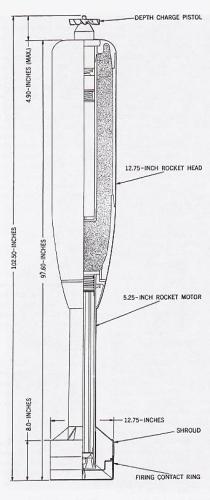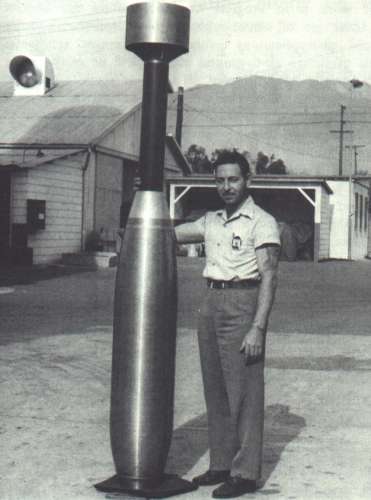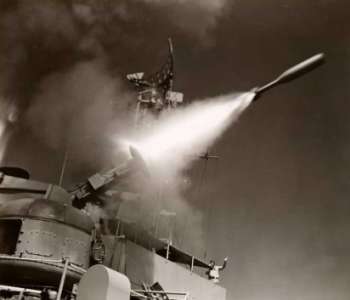NOTS RUR-4 Weapon Alpha
As sonar technology progressed at the end of World War II it became desirable to launch depth charges to greater distances from the destroyer to engage submarines at the larger detection ranges made possible by the new sonars. In 1946, the NOTS (Naval Ordnance Test Station) at China Lake started development of two rocket-boosted depth charges, called "Weapon A" and "Weapon B". These differed only in the weight of the charge, being 113 kg (250 lb) for 'A' and 23 kg (50 lb) for 'B'. Because the latter was eventually calculated to be not powerful enough to sink a fast submarine, it was abandoned. Development of "Weapon A" (usually referred to as Weapon Able, and later as Weapon Alpha (or Alfa)) continued through 1950, and it was first deployed on U.S. Navy destroyers in 1951.
 |
 | |
| Drawing: via DE-220 Website | Photo: U.S. Navy | |
| Weapon Alpha (RUR-4A) | ||
The Weapon Alpha rocket projectile was a simple 32.4 cm (12.75 in) warhead attached to a solid-propellant rocket, which boosted it to a range of about 730 m (800 yd). The warhead casing was made of plastic, because the fuzing mechanism required non-magnetic construction. The rocket was fired from MK 108 launchers, which somewhat resembled standard 12.7 cm (5 in) gun turrets. The MK 108 launcher could fire up to 12 rounds per minute. After the Weapon Alpha rocket entered the water, it sank at about 11.5 m/s (38 ft/s). There were two different types of rocket, designated 12.75-Inch Underwater Rocket MK 1 MOD 0 and MK 2 MOD 0. The MK 2 variant had a slightly improved motor.
 |
 | |
| Photo: via USS Lester Website | Photo: National Archives | |
| MK 108 launcher | Weapon Alpha (RUR-4A) |
In 1963, the Weapon Alpha rocket was designated as RUR-4A. It remained in service until 1969, when the last systems were replaced by the RUR-5 ASROC.
Specifications
Note: Data given by several sources show slight variations. Figures given below may therefore be inaccurate!
Data for RUR-4A:
| RUR-4A (MK 1) | RUR-4A (MK 2) | |
|---|---|---|
| Length | 2.60 m (8 ft 6.5 in) | |
| Diameter | 0.32 m (12.75 in) | |
| Weight | 238 kg (525 lb) | |
| Speed | 85 m/s (280 ft/s) | |
| Max Flight Time | 10.9 s | 14.2 s |
| Range | 270-695 m (300-760 yd) | 230-890 m (250-975 yd) |
| Propulsion | 5.25" solid-fueled rocket motor | |
| Warhead | 113 kg (250 lb) HE depth charge | |
Main Sources
[1] Norman Friedman: "US Naval Weapons", Conway Maritime Press, 1983
[2] J.D. Gerrard-Gough, Albert B. Christman: "The Grand Experiment at Inyokern", Naval History Division, 1978
Back to Current Designations Of U.S. Unmanned Military Aerospace Vehicles
Back to Directory of U.S. Military Rockets and Missiles
Last Updated: 11 December 2025